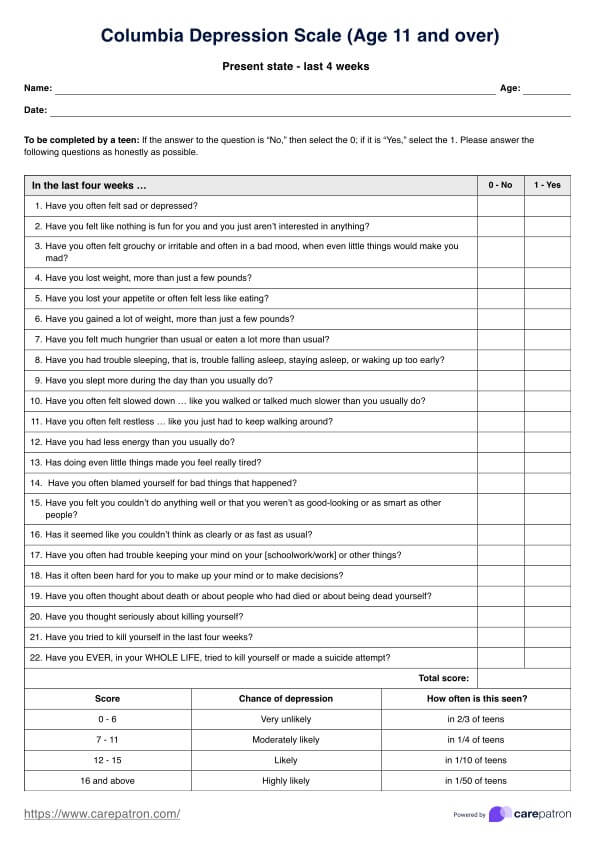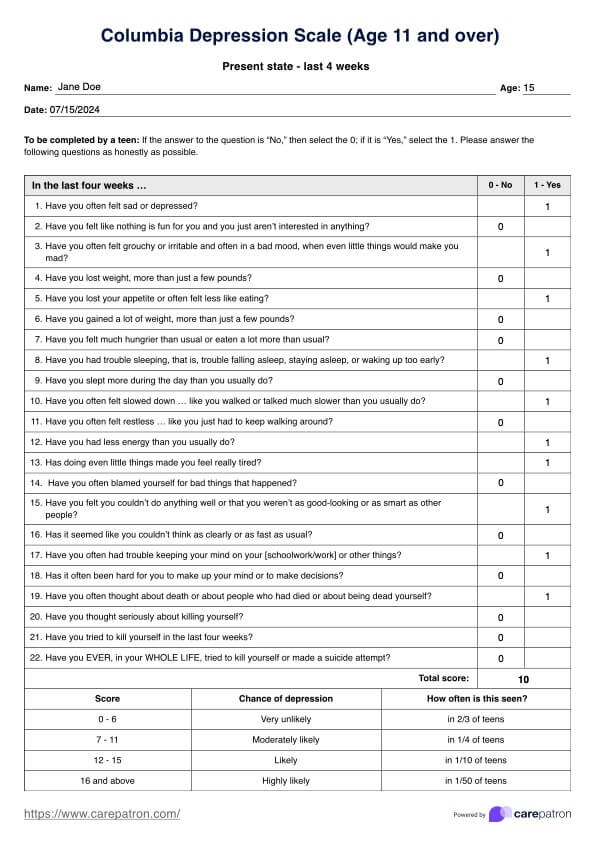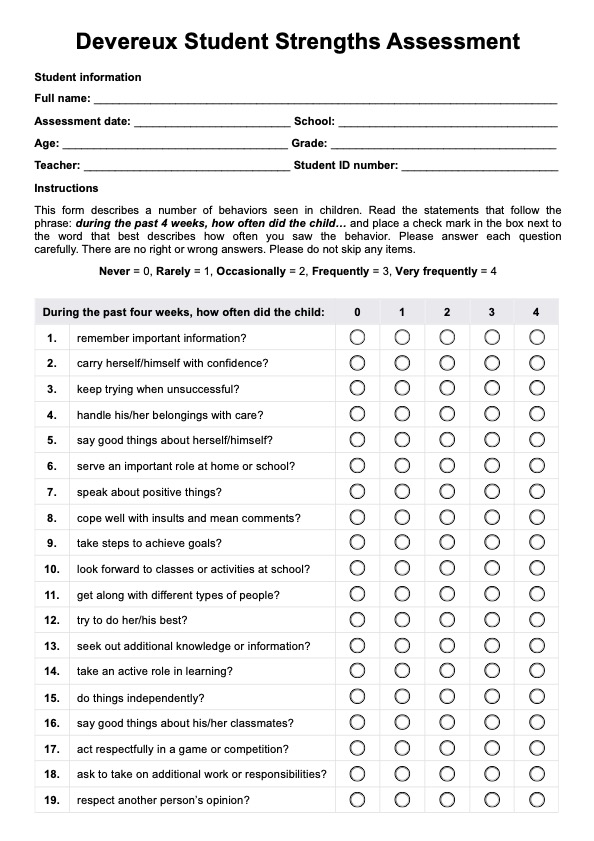Columbia Depression Scale
A guide for mental health professionals on the Columbia Depression Scale (CDS), covering its application, scoring, and interpretation to enhance patient care.


What is the Columbia Depression Scale?
The Columbia Depression Scale (CDS) is an important tool for spotting depression in children and adolescents aged 11 and up. Originally developed by experts at Columbia University, the CDS was created to address the need for reliable and effective screening tools for mental health conditions like depression in younger age groups, such as high school students.
It consists of 22 yes/no questions that cover symptoms like:
- Feelings of sadness or depression
- Loss of interest in activities
- Irritability and bad mood
- Changes in appetite and weight
- Sleep disturbances
- Fatigue and low energy
- Feelings of worthlessness or guilt
- Difficulty concentrating
- Suicide risk and attempts
The Columbia Depression Scale is a screening tool completed by both the adolescent and a parent/caregiver. The adolescent (aged 11 and over) completes the 22 yes/no questions on the to self-report their symptoms of depression. There is also a parent version. This version also has 22 items but worded slightly differently from the teen version and focus on the symptoms observed by the parent or caregiver.
What is the goal of the Columbia Depression Scale?
By using the CDS, healthcare providers can catch early warning signs, facilitate timely interventions, and ultimately improve mental health outcomes for young patients. This is especially important for addressing mental health disorders such as major depressive disorder or drug abuse problems.
The scale acts as a brief depression severity measure, which is crucial for adolescent primary care patients. Early identification can help prevent more severe mental disorders and reduce the risks associated with substance abuse. Furthermore, the CDS aligns with guidelines set by the preventive services task force, emphasizing its role in promoting proactive mental health care.
How is the CDS scored, and how are the results interpreted?
Here's how each version is scored and interpreted
Teen version
Each "No" response scores 0, and each "Yes" response scores 1. The total score ranges from 0 to 22, which is interpreted as follows:
- 0-6: Very Unlikely to have depression (seen in 2/3 of teens)
- 7-11: Moderately likely to have depression (seen in 1/4 of teens)
- 12-15: Likely to have depression (seen in 1/10 of teens)
- 16 and above: Highly likely to have depression (seen in 1/50 of teens)
Parent version
Scoring the parent version follows the same method: each "No" response scores 0, while each "Yes" response scores 1. However, the score is interpreted slightly differently:
- 0-4: Very unlikely to have depression (seen in 2/3 of teens)
- 5-9: Moderately likely to have depression (seen in 1/4 of teens)
- 10-12: Likely to have depression (seen in 1/10 of teens)
- 13 and above: Highly likely to have depression (seen in 1/50 of teens)
The scores from the teen and parent versions are then considered together to get a comprehensive assessment of the adolescent's depression risk. Higher scores on both versions indicate a greater likelihood of depression.
Columbia Depression Scale Template
Columbia Depression Scale Example
How to use our Columbia Depression Scale template
Our Columbia Depression Scale PDF template streamlines the administration and scoring process for healthcare providers. Here’s how to effectively use it in primary care settings:
- Download the template: Visit our website and locate the CDS template through the resources tab. Click the download link to save the document to your computer or mobile device.
- Print or digitally share: Depending on your preference and the resources available, you can print the form to provide a physical copy or fill it in digitally.
- Administer the questionnaire: Give a copy of the CDS to either the teen or their parent. Make sure you're giving the correct version based on who is answering the assessment.
- Score the questionnaire: After completing the CDS, use the included scoring guide and interpretation guide to determine the severity of the teen's depression symptoms.
- Discuss results and provide appropriate care: Use the score to guide your discussion with the patient or parent about next steps for managing their mental health. Offer referrals, resources, and support as needed.
How this scale benefits mental health professionals
The Columbia Depression Scale offers several benefits for mental health professionals:
- Efficient screening tool: Quickly identifies adolescents at risk for depression, enabling timely intervention and reducing the likelihood of severe outcomes.
- Structured assessment: Provides a clear, standardized method for assessing depressive symptoms, ensuring consistency and accuracy in diagnosis.
- Facilitates communication: Helps convey the severity of symptoms to caregivers and other healthcare providers, fostering a collaborative approach to patient care.
- Supports clinical decisions: It guides whether further psychological evaluation or treatment is necessary, aiding in developing effective, personalized treatment plans.
Commonly asked questions
The Columbia Depression Scale (CDS) is a highly accurate and reliable screening tool for identifying potential depression in adolescents aged 11 and older. Research has demonstrated that the CDS has strong psychometric properties, good sensitivity and specificity, and is effective in diverse populations.
The CDS is specifically designed for adolescents aged 11 and over. For adults, other depression assessment tools like the Beck Depression Inventory or patient health questionnaire (PHQ-9) may be more appropriate.
The frequency of administration depends on the clinical setting and the patient's needs. It can be used periodically to monitor changes in depressive symptoms over time.
No specific training is required to administer the CDS. However, healthcare professionals should know the scoring and interpretation guidelines to use the tool effectively.

.jpg)


















-template.jpg)



















































































